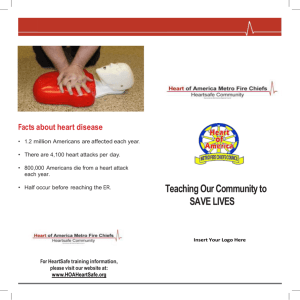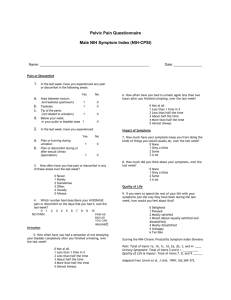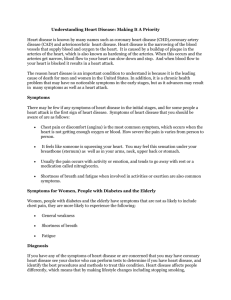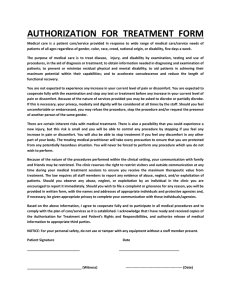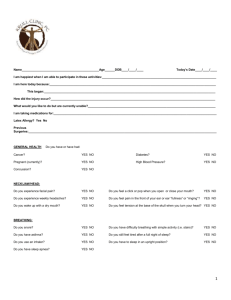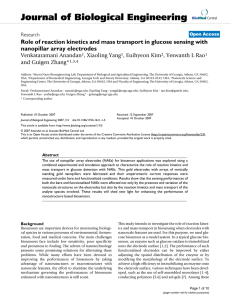File - The Effect of Music Tempo on Heart Rate and Blood
advertisement
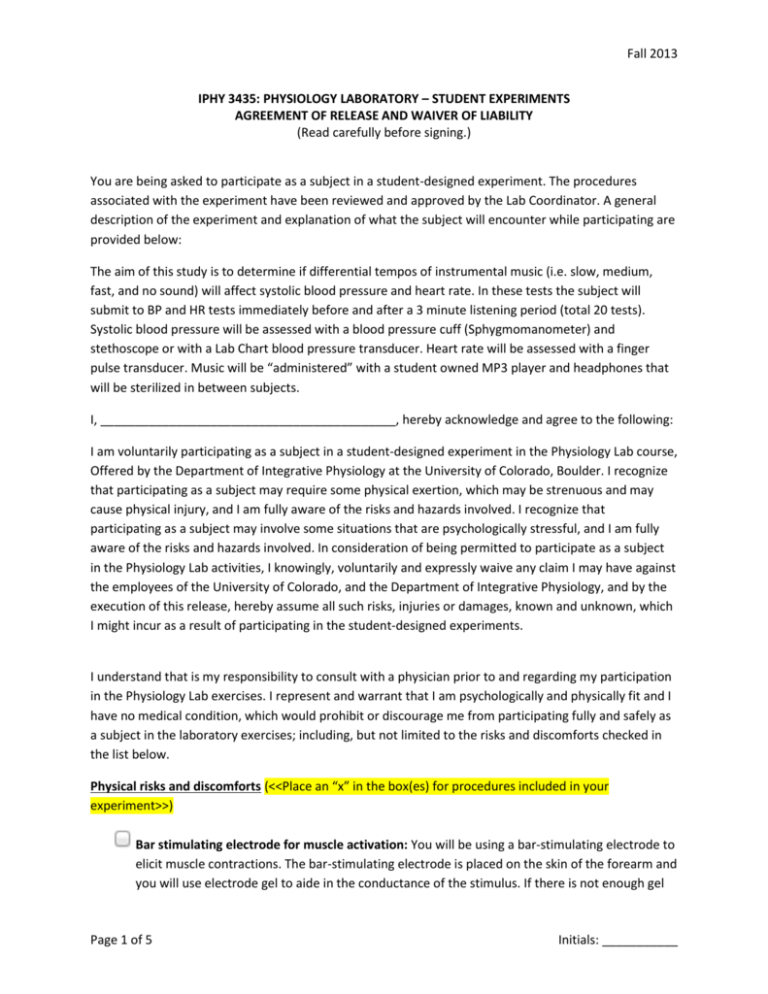
Fall 2013 IPHY 3435: PHYSIOLOGY LABORATORY – STUDENT EXPERIMENTS AGREEMENT OF RELEASE AND WAIVER OF LIABILITY (Read carefully before signing.) You are being asked to participate as a subject in a student-designed experiment. The procedures associated with the experiment have been reviewed and approved by the Lab Coordinator. A general description of the experiment and explanation of what the subject will encounter while participating are provided below: The aim of this study is to determine if differential tempos of instrumental music (i.e. slow, medium, fast, and no sound) will affect systolic blood pressure and heart rate. In these tests the subject will submit to BP and HR tests immediately before and after a 3 minute listening period (total 20 tests). Systolic blood pressure will be assessed with a blood pressure cuff (Sphygmomanometer) and stethoscope or with a Lab Chart blood pressure transducer. Heart rate will be assessed with a finger pulse transducer. Music will be “administered” with a student owned MP3 player and headphones that will be sterilized in between subjects. I, ___________________________________________, hereby acknowledge and agree to the following: I am voluntarily participating as a subject in a student-designed experiment in the Physiology Lab course, Offered by the Department of Integrative Physiology at the University of Colorado, Boulder. I recognize that participating as a subject may require some physical exertion, which may be strenuous and may cause physical injury, and I am fully aware of the risks and hazards involved. I recognize that participating as a subject may involve some situations that are psychologically stressful, and I am fully aware of the risks and hazards involved. In consideration of being permitted to participate as a subject in the Physiology Lab activities, I knowingly, voluntarily and expressly waive any claim I may have against the employees of the University of Colorado, and the Department of Integrative Physiology, and by the execution of this release, hereby assume all such risks, injuries or damages, known and unknown, which I might incur as a result of participating in the student-designed experiments. I understand that is my responsibility to consult with a physician prior to and regarding my participation in the Physiology Lab exercises. I represent and warrant that I am psychologically and physically fit and I have no medical condition, which would prohibit or discourage me from participating fully and safely as a subject in the laboratory exercises; including, but not limited to the risks and discomforts checked in the list below. Physical risks and discomforts (<<Place an “x” in the box(es) for procedures included in your experiment>>) Bar stimulating electrode for muscle activation: You will be using a bar-stimulating electrode to elicit muscle contractions. The bar-stimulating electrode is placed on the skin of the forearm and you will use electrode gel to aide in the conductance of the stimulus. If there is not enough gel Page 1 of 5 Initials: ___________ Fall 2013 used, or the skin is extremely sensitive, it is possible to burn the skin during stimulation. Electrical stimulation may deliver a shock strong enough to produce pain and discomfort. The involuntary contraction of your muscles, in response to the stimulus, may create a tingly or prickling sensation. Blood pressure measurements: Blood pressure measurements will be taken with either a LabChart blood pressure transducer that shows a digital output recording of a subject’s blood pressure, or using a manual method with a sphygmanometer and stethoscope. You will feel a squeeze on your arm while the blood pressure cuff is inflated, but this will not last for more than 30 seconds. Electrocardiography (ECG): An electrocardiogram is a safe procedure. There may be minor discomfort, similar to removing a bandage, when the electrodes taped to your body to measure your heart's electrical signals are removed. Rarely, a reaction to the electrodes may cause redness or swelling of the skin. Electroencephalography (EEG): Electroencephalography is a method by which electrical activity of the brain can be noninvasively recorded through the use of recording electrodes. The electrodes will be placed on various locations around the scalp and there will be electrode paste between the electrode and the scalp. An elastic band will be placed around the head to keep the electrodes in the proper position. Rarely, a reaction to the electrodes or electrode paste may cause redness or swelling of the skin. Cycle ergometer aerobic exercise: There are inherent risks associated with aerobic physical activity. Aerobic exercise may result in a fast or slow irregular heart rhythm, abnormal blood pressure changes, light-headedness, dizziness, fainting, chest pain, and other discomforts. Any type of physical activity may in rare instances lead to heart attack, stroke, or death, but this is unusual, especially if participants are free of known coronary heart disease (CHD), free of any signs or symptoms of CHD, and with few major risk factors of CHD. Please avoid participation in exercise experiments if you have any heart conditions. Facial submersion in cold water: You will submerge your face in cold water during this lab. Coldwater submersion without a scuba mask or snorkel can produce some discomfort and anxiety as a result of the contact between your face and the cold water and from holding your breath during the submersion. Finger stick capillary blood collection: The risks of blood draws through finger pricks are minimal. A small percentage of individuals experience lightheadedness and fainting when exposed to blood. Some momentary pain will be felt while the finger is being pricked. If you have experienced fainting at the sight of blood in the past, please inform the instructor. Please be cognizant of the exposure risks that blood sampling poses to the rest of the class and use the proper personal protective equipment (gloves, glasses, lab coats) during the lab. Page 2 of 5 Initials: ___________ Fall 2013 Muscle force measurement procedures: You will squeeze a hand dynamometer or place your finger against a pulse pressure transducer so that we can measure your muscle force. These procedures should not produce any pain or discomfort, but your muscles may become fatigued after repeated measurements. Oral caffeine intake: You will consume a caffeinated beverage that contains ________ grams of caffeine. Some participants may experience nausea or vomiting after drinking the caffeinated beverage. Drinking a caffeinated beverage can cause an acute increase in your heart rate and blood pressure. If you have a cardiac problem, you should not participate in this experiment. Oral glucose intake: You will consume a flavored glucose drink that contains 75 grams of glucose. Some participants may experience nausea or vomiting after drinking the glucose. Drinking highly concentrated glucose will cause an acute increase in your blood glucose levels. If you are a known diabetic or pre-diabetic, you should not participate in this experiment. It is possible that your blood glucose levels will remain elevated for an extended period of time following this task. Urinary glucose assessment: This test involves only normal urination and there is no discomfort. There is no risk associated with this test; however, we do ask that you wash your hands after you have completed the test so that you do not risk exposing your classmates to biological pathogens. You will need to use the restrooms in the Ramaley building for this test, but you will do it on your own, without the help of any of your lab partners. Ventilation of altered gas mixtures: For the mystery gas experiment, you will breath various gas mixtures during this experiment (room air, 10% O2, 15% O2, and 6% CO2) for a period of no greater than 5 minutes. While these gas mixtures are safe to breath for 5 minutes, you could experience shortness of breath, an increased heart rate, faintness, nausea, trembling, dizziness, and other unusual body sensations. If you are pregnant, or have heart disease, lung disease, or a seizure disorder, you should not participate in the mystery gas experiment. For the breathholding experiment, you will perform an intervention that causes you to be either hypercapnic or hypocapnic, then you will try to hold your breath for as long as possible. Breath holding is voluntary and you can stop holding your breath whenever you would like, so there is no risk involved in the procedure. Other: Students volunteers will submit to 5 minute music listening periods. Discomfort may be incurred as a result of music volume and headphone chaffing. Care will be taken to minimize said discomfort and volunteers may elect to discontinue administration of music at any time. Psychological risks and discomforts Psychological stressors: You may experience some psychological discomfort when asked to participate in an experiment that involves a psychological stressor. Psychological stressors can Page 3 of 5 Initials: ___________ Fall 2013 produce feelings of anxiety, embarrassment, frustration, anger, sadness, nervousness, or other feelings. You will be given the opportunity to discontinue the test if you appear to be experiencing an adverse reaction. Ventilation of altered gases: Some individuals may experience some anxiety due to the sensations brought on by breathing the mystery gases; however, these sensations last only as long as you are breathing the gas and you can discontinue at any time if you are uncomfortable. Other: Students may experience some anxiety or some milieu of emotional discomfort during the music listening period (depending on the tempo and subject’s preference for the music). However, these feelings will only persist through the duration of the music administration and the subject can elect to discontinue the treatment at any time. I am aware that no medical practitioners are present during these laboratory exercises and that I participate at my own risk. I understand that I am not obligated to serve as a test subject in any laboratory exercises of this course, and that if I do choose to participate, I can drop out at any time. I understand that my decision not to participate as a test subject in these laboratory exercises will have no influence on my grade in this course. I have read the above release and waiver of liability and fully understand its contents. I voluntarily agree to the terms and conditions stated above. SIGNATURE: _______________________________________________________________________ PRINTED NAME: ____________________________________________________________________ DATE: ____________________________________________________________________________ Page 4 of 5 Initials: ___________ Fall 2013 <<Complete the following with your group’s information.>> GROUP MEMBER NAMES: Isabella Asamoah, Logan Bannon, Parsa Ghasem Anna Vavra, SECTION DAY/TIME: Monday AM TA/INSTRUCTOR: Jim Peterman <<When you are finished customizing this consent form, delete all of the instructions that are highlighted in yellow and save the document as “Consent_Name1_Name2_Name3_Name4.” Email the document to your TA/Instructor by the end of your lab section during the week of 12/2/13. Make sure to print off enough consent forms for the number of subjects that you will include in your experiment.>> Page 5 of 5 Initials: ___________

